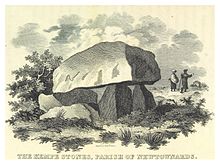Kempe Stones
The Kempe Stones , also known as Greengraves , are a portal tomb in a field near Dundonald , west of Newtownards , embedded in a hedge of gorse (Ulex gallii) in County Down in Northern Ireland . They are a good example of the rarer two-capped dolmens of this type. Other facilities of this type are Aughnacliff in County Longford , Knockeen in County Waterford and Kilmogue in County Kilkenny and the Haroldstown Dolmen . The facility is a Scheduled Monument .
The high portal stones are well coordinated and support the thicker, front cap stone. The back of this large capstone rests on the second, much smaller capstone, which in turn rests on the three end and side stones. The stones form a polygonal chamber. There is also some stone material around the megalithic complex , but it is unknown whether this is original. Around 1830 human bones were found in the megalithic complex.
The word "Kempe" means fighter (knight), suggesting that the dolmen was considered to be a soldier's grave. "Green" (by Grenngraves) is a corruption of the legendary figure Gráinne , who was forced to flee with her lover Diarmuid . You travel through Ireland and spend only one night at each location, which leads to a large number of “Dermot and Grania beds” ( Irish Leaba - English Labba ) or caves.
Nearby is the Ballygraffan's Tomb portal .
See also
literature
- Elizabeth Shee Twohig: Irish Megalithic tombs (= Shire Archeology. 63). Shire Publications, Princes Risborough 1990, ISBN 0-7478-0094-4 .
Web links
- Description and pictures (last accessed on December 5, 2013)
- Brief description (English) and pictures (last accessed on December 5, 2012)
- Images (last accessed December 5, 2012)
- Description and pictures
Coordinates: 54 ° 35 '24 " N , 5 ° 45' 55.3" W.

